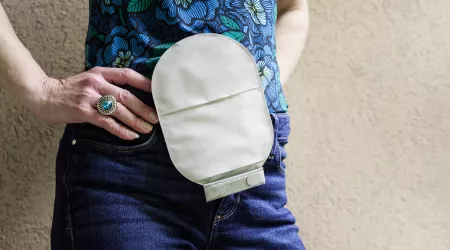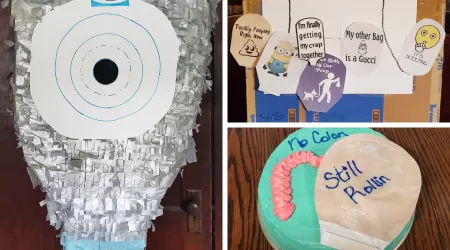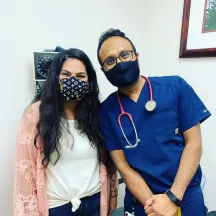Kat Sisler: From ostomy-opposed to ostomy-grateful
Contributed by: Kat Sisler
My cancer and ostomy journey began with a rude awakening in January 2023. My father was diagnosed with colorectal cancer at 42, and given that history, I asked my doctor at my yearly physical when I should begin screening. It was a little early — based on the current guidance, I technically wouldn’t have to start until age 32 — but I work in public health and know the importance of prevention and screening. We went ahead and scheduled a colonoscopy to establish a baseline.
My husband and I were given the surprise of our lives when the gastroenterologist discovered my colon was nearly fully obstructed by a sizeable tumor. And no, before you ask, I wasn’t having any symptoms. At the time, I was training for my first half marathon and was possibly in the best shape of my life.
We couldn’t believe this was happening. I was only 30 years old! A whirlwind of doctors appointments, phone calls, scans, and blood work culminated in a sooner-than-expected surgery a few weeks later as the tumor fully obstructed and I could no longer eat or go to the bathroom. A few days after surgery, the pathology report came in: stage IIIb.
The Ostomy
Going into the surgery to remove the tumor, our surgeon had told us she was going to do everything she could to avoid an ostomy, but that it was a possibility we had to be ready for, given that I was unable to clean out. We discussed an advance directive to be prepared for any and all outcomes. Even when the nurse was marking me up to identify the best possible placement for an ostomy, I kept telling my husband the one thing I didn’t want to end up with was an ostomy. Intubation? No strong opinion. Heroic measures? My husband can decide. Ostomy? Absolutely not.
So, of course, what do I wake up with? An ostomy.
Prior to this moment in my life, I hardly knew anything about ostomies, let alone how common they were for those who are impacted by colon/rectal cancer or gastrointestinal issues such as Crohn’s or diverticulitis, to name a few. Two major types of ostomies can result from the above challenges: a colostomy (opening of the colon into the abdominal wall to form what is called a stoma) or ileostomy (opening of the small intestines into the abdominal wall, also called a stoma). A urostomy is a third option, but it deals with the bladder, rather than the digestive tract. Any of these can be permanent or temporary, depending on a host of factors, and have major emotional and psychological implications. In my specific case, I have a temporary colostomy that we were told would be reversed after I finished chemotherapy and a rest period.
On February 17, I woke up with a colostomy and a ~6-inch vertical incision in the middle of my belly, along with a few other new scars. I sobbed. I felt disgusting. I thought my ability to run and do other things I loved was over. Three days before going into surgery, I had still been running in preparation for the half marathon. To go from that to not being able to sit up by myself and managing this foreign thing called a “stoma” that was producing “output” hit so, so hard. Being told the ostomy would probably be temporary sounded reassuring in theory, but I still felt overwhelmed by the idea of living with it in the meantime.
A Shock to My System
The first month or so was incredibly challenging. I was battling complications from major surgery and had to learn a whole new way of going to the bathroom. While in the hospital, specialized nurses certified in Wound, Ostomy, and Continence (WOC) care came to teach me how to take care of the stoma: how to keep my skin healthy, what all of the various supplies were and how to use them, and what to expect/keep an eye out for. But right away, I noticed something in the resources I was provided.
As we know, young-onset colorectal cancer cases are growing rapidly, with more individuals facing the potential of an ostomy during their journey. Many of the resources I was given featured people who were decades older than I am. It felt like ostomies were only something that happened to older adults, as most stories I heard from nurses or doctors were about older adults they had worked with. At 30, I felt very alone in this experience.
Living With It
Fortunately, things didn’t stay that way forever. As we approach Ostomy Awareness Day, I’ve had the opportunity to reflect on how much I’ve learned since that jarring awakening in February. No matter what age group you might fall into, I firmly believe that anyone can have a great life with an ostomy. Here are some things I learned through my experience that I hope can help others in their journey:
Find a WOC nurse to support you (and don’t give up until you find someone right for you). After being discharged from the hospital, my surgeon recommended following up with an outpatient WOC nurse clinic to help answer any care questions I had. This turned out to be a total game-changer. I was fortunate to eventually connect with an incredible WOC nurse who talked me and my husband through all the different kinds of supplies and setups that exist, pros and cons of each, specific products for my specific stoma, helped us get samples, and generally built our confidence. However, we had to meet a few nurses before we found the “right” one for us. If you have a subpar experience with one nurse, or haven’t found one yet, keep looking. Some insurances offer the option of home health, where a nurse comes to you. No matter what, it is so valuable to have someone who can help you navigate ostomy care in a way that fits your body and lifestyle, particularly within the steep learning curve of those first few weeks to months.
Give your core lots and lots of TLC! After surgery (like many major surgeries) you’re told to avoid lifting anything heavy for a period of time. Additionally, if your surgeon is thoughtful, they’ll also highlight the risk of hernia that comes with abdominal surgery. However, just because you’re told not to lift doesn’t mean you should do nothing! Repairing and restoring your core is vital to ensure you can return to the types of activities you enjoyed before surgery. There are physical therapists who specialize in the pelvic floor and core that can support you in recovery. I was fortunate to get a referral to a pelvic floor PT after surgery and can’t recommend this enough. Check with your insurance to see what is covered. Additionally, there are resources available specifically for us “ostomates” on our road to recovery - The Ostomy Studio is a great example. It isn’t about getting a six-pack, but rather making sure this vital part of your body is strengthened and cared for, leading to a reduced risk of hernia and better overall posture.
Relatedly, even though it doesn’t feel like it at first, you can do anything you used to do without an ostomy, with one. Used to be a runner? Swimmer? Wrestler? There are many examples of folks who now have an ostomy that continue to do these things - including myself! Roughly six weeks after my surgery, I was able to (slowly!) start running again. I worked with my pelvic floor physical therapist to make sure my core was stable enough, then started back with a very slow jog for 30-60 seconds at a time. Some products can help build your confidence in doing these things, such as Stealth Belt (great for running/general support) or wafer extenders (great for doing anything in the water - swimming, surfing, going in a hot tub or bath, etc).
Lastly, seek out others you can relate to. Social media can be helpful in this situation - there are many different individuals out there living with ostomies doing amazing things and sharing their experiences. When ostomy materials felt alienating, I found comfort when I discovered other people in my age group documenting their ostomy tips on social media. There are also Facebook groups that can provide support and guidance. Finding a community can help you not only learn but feel much less alone in the process.
A Parting Thought
I never imagined I’d feel this when I first woke up with my colostomy, but I’m grateful for it now. Today, the “me” of February 2023 feels very distant. Ninety percent of the time, you’d never know I had an ostomy (or cancer, on my better days!). I have a much better handle on things. I wish I could tell you that I found a single resource that changed everything, but truthfully, it took time, trial and error, and patience. Plus lots of learning from others.
Humans are resilient. We adapt to what is thrown at us in remarkable ways. If you or someone you love or know has ended up with an ostomy, whether permanent or temporary, know that it will be okay. It’s hard. It will take learning and adjusting. A sense of humor will be helpful. You will cycle through so many emotions, but your life is by no means over. You’ve got this.
Top resources

Empowering lives: celebrating World Ostomy Day
Every year on the first Saturday of October, people worldwide come together to celebrate World Ostomy Day, also known as Ostomy Awareness Day. This day serves as a reminder of the resilience, strength, and courage millions of individuals display each year living with an ostomy.
How to cut and fit an ostomy wafer for a stoma
In this video, ostomate and certified patient and family support navigator Stephanie Rouse demonstrates how to cut and fit an ostomy wafer, or skin barrier, for a stoma.

How to throw the best stomaversary party
This is such an important day of your colorectal cancer journey that you should celebrate!





